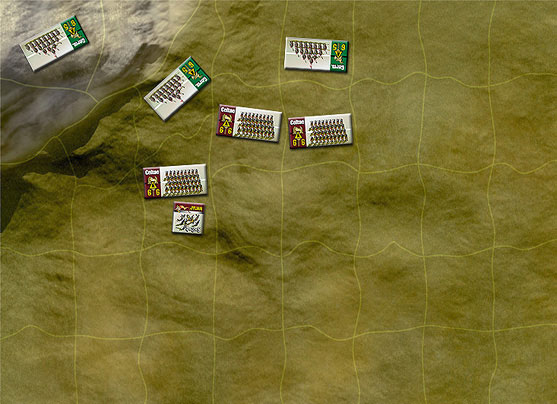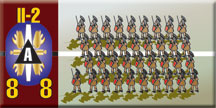| Rome at War:
Publisher’s Overview
By Mike Bennighof, Ph.D.
February 2018
 Rome at War captures what a wargame should be: there are no charts, there are no markers. You line up your troops, you move them, and you fight with them (by rolling dice; a six equals a hit). And pretty much, that’s the essence of the game. Rome at War captures what a wargame should be: there are no charts, there are no markers. You line up your troops, you move them, and you fight with them (by rolling dice; a six equals a hit). And pretty much, that’s the essence of the game.
I’ve never designed a game in our Rome at War series, but I’ve always had a great liking for it. It’s derived from the area-movement games we did for Napoleon, Civil War and Imperial Age battles (like Battles of 1866: Frontier Battles), but with a significant difference. In those games, a map of the battlefield is divided into unevenly-shaped areas based on the actual terrain. The size of the areas, and their alignment with other areas, is determined by the lay of the land.
In theory that makes for an accurate portrayal of a battle; in practice I’m not so sure it doesn’t give the player detailed topographic information not available to his or her historical counterpart.

For the ancient era, the detailed-area concept wasn’t a really good approach. Ancient armies fought in long lines (which is why it’s called “linear warfare”); sometimes they formed pretty deep formations but lines and squares remained the basis of tactical organization into the late 19th Century. Communications technology dictated that approach to a large extent; lacking radio, armies and their subordinate formations could only be directed by verbal or visual cues. Weaponry also played a large part, as the troops had to literally face their opponents to inflict damage on them with sword and spear. The increasing importance of missile fire in the late Roman period caused some alterations in tactics, but the lines and squares still dominated the battlefield.
The sites of many, if not most, ancient battles are disputed today, so it’s a pretty easy step to take that concept of squares and apply it to a generic battlefield map. Most ancient battles took place on pretty flat and featureless terrain, the better for all those squares and lines to move about. Rome at War’s maps are divided into squares, and in keeping with ancient battlegrounds have limited terrain features (some hills, some woods) that deviate from the grid.
 When it’s time to move those troops, you do it through activating formations. Each army has a commander, and several subordinate commanders under him. The commander determines when and how often the formations will be activated, but it’s the subordinate commanders who do the heavy lifting. They lead the troops into battle, fight alongside them, and sometimes die there. When it’s time to move those troops, you do it through activating formations. Each army has a commander, and several subordinate commanders under him. The commander determines when and how often the formations will be activated, but it’s the subordinate commanders who do the heavy lifting. They lead the troops into battle, fight alongside them, and sometimes die there.
Combat is resolved fairly simply: roll a six, get a hit. Units are rated for combat strength and morale, and appear at several strength levels – just two “steps” for small units like cavalry, archers and light infantry and anywhere from three to six for heavy infantry. Units with better morale have a better chance to stand their ground against things like cavalry charges.
Some units get to charge (cavalry, elephants, chariots, barbarians) while others can loose missiles (archers for the most part; the Romans sometimes have spring-loaded battlefield artillery). These special attacks can give special bonuses in combat. A good leader can also add to his units’ strength.
Heavy infantry is the solid rock of Hannibal at Bay, the introductory game to the series and the earliest setting published so far (ca. 200 years BC). In Queen of the Celts, the “middle” game in terms of the timeline, the Roman legions are still supreme and the Celts try to match them with their own hopelessly brave masses of foot soldiers.
By the time of Fading Legions and its expansion book, King of Kings (Fourth Century AD), things have changed. Rome still fields “legions,” but they are much smaller. Missile-firing troops have become much more powerful with the advent of better bows, and very heavy cavalry (with both man and horse armored in chain or plate mail) has now appeared on the battlefield. Warfare is now much more of a combined-arms affair.
 Elephants appear in all three eras (just one Roman elephant in Queen of the Celts). Elephants can be effective battlefield weapons, particularly when it comes to repelling cavalry (horses fear elephants), but they can also turn on their masters when maddened by confusion or pain. But games are definitely cooler when they include elephants. Elephants appear in all three eras (just one Roman elephant in Queen of the Celts). Elephants can be effective battlefield weapons, particularly when it comes to repelling cavalry (horses fear elephants), but they can also turn on their masters when maddened by confusion or pain. But games are definitely cooler when they include elephants.
And that’s the essence of Rome at War: quick and easy game play, striking visuals, and heaps of history. And elephants.
You can order Rome at War games right here!
Mike Bennighof is president of Avalanche Press and holds a doctorate in history from Emory University. A Fulbright Scholar and award-winning journalist, he has published over 100 books, games and articles on historical subjects.
He lives in Birmingham, Alabama with his wife, three children and his dog, Leopold. Leopold does not fear elephants.
|
